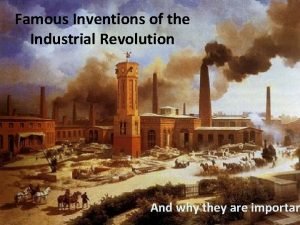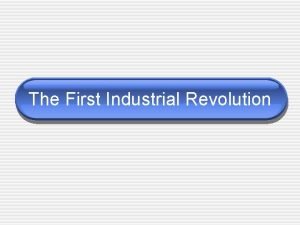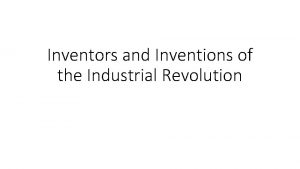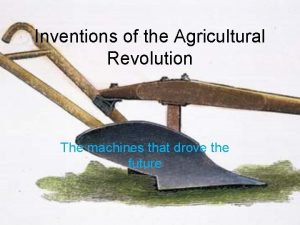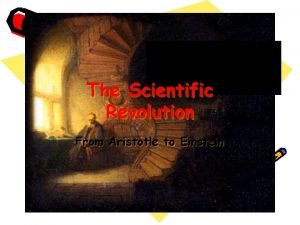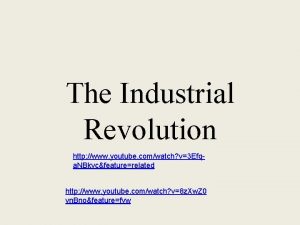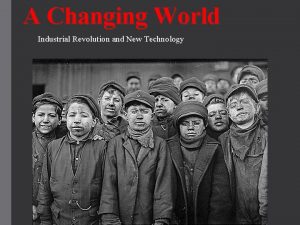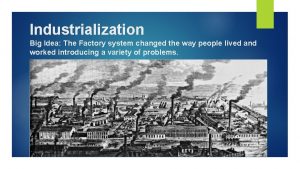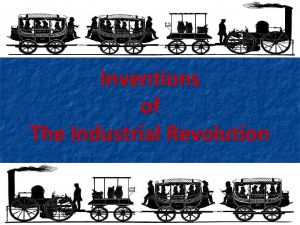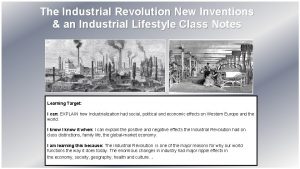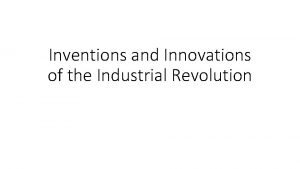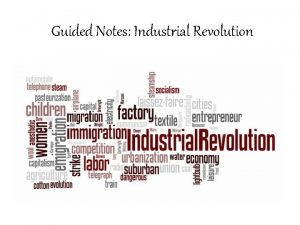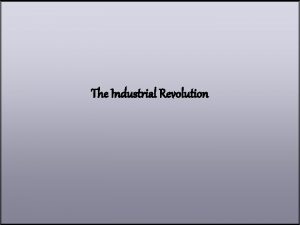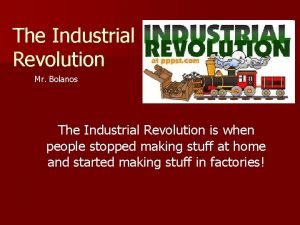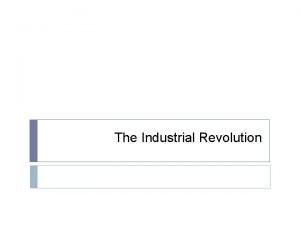The inventions of the Industrial Revolution Inventions of














- Slides: 14

The inventions of the Industrial Revolution

Inventions of the I. R. Name of invention and inventor Description How did this revolutionize the world?

Eli Whitney & the Cotton Gin ® American Inventor ® Cotton Gin Removes seeds from cotton ® 1790—US produces 1. 5 million pounds of cotton per year ® 1800—US produces 85 million pounds of cotton per year ®

James Watt and the Steam Engine ® Scottish Inventor ® Modified a previous steam engine used for pumping water out of mine shafts (in the late 1700’s)

Steam Engine Heat & water Steam Pressure pulls water from mine shafts

Water Transportation ® Steam powers used to power boats ® Creation of canals/ waterways ® Crossing the Atlantic: 1800: About three months ® 1880: (steam) 2 -3 weeks ® 1910: about one week ®

® 1829, ®First The Rocket Locomotive 24 mph, 13 tons

Growth of the Train in Britain 1830— 70 miles of track • 1840— 4, 500 miles • 1870— 15, 000 miles •

Thomas Edison and Electricity ® American Inventor ® Created the light bulb, recorder player and video projector. ® Effects: Factory could be open at night ® Cities were safer ® Entertainment ®

Electricity led to: ® Communication ® Telegraph—send a message 100 miles in minutes (Morse code) ® 1876 telephone ® 1901 Radio ® Other uses ® Sewing machines, trolleys, fans, light bulbs

Henry Bessemer and Steel ® English Inventor ® Created a cheap and easy way to make steel alloy (a mixture of metals) in the mid 1800’s

Steel and Petroleum ® Steel ® ® Replaced iron Harder and more flexible Tools, Buildings (skyscrapers) and transportation (Brooklyn Bridge) Oil ® Originally used for grease…later purified and used for fuel ® ® Found in Russia, Sweden, Poland, the US Replaces coal Easier to transport Leads to automobiles (1885) and planes (1901)

Louis Pasteur and Vaccines ® French Scientist ® Study how bacteria leads to illness ® Invented pasteurization of milk and vaccines against many illness

Medicine and Chemistry ® Modern Medicine ® Antiseptics (clean tools), Pain killers, Vaccines, etc. ® Modern Chemistry ® Dyes, preservatives for food, medicines and fertilizers, Dynamite ® Nitroglycerin used by was first invented by an Italian chemist in 1846. Alfred Nobel understood that it was volitile and in 1866 he discovered that mixing nitroglycerine with silica would turn the liquid into a malleable paste, called dynamite. Used for mining.
 Famous inventions of the industrial revolution
Famous inventions of the industrial revolution Eli whitney interchangeable parts
Eli whitney interchangeable parts Bessemer process
Bessemer process Agricultural revolution inventions
Agricultural revolution inventions Scientific revolution inventions
Scientific revolution inventions Economic causes of french revolution
Economic causes of french revolution The third agricultural revolution
The third agricultural revolution Russian revolution vs french revolution
Russian revolution vs french revolution Enclosure movement definition industrial revolution
Enclosure movement definition industrial revolution Sasprin
Sasprin Germ theory inventor description
Germ theory inventor description Manchester in the industrial revolution
Manchester in the industrial revolution William cooper industrial revolution
William cooper industrial revolution Long term impacts of the industrial revolution
Long term impacts of the industrial revolution Industrial revolution jeopardy
Industrial revolution jeopardy
